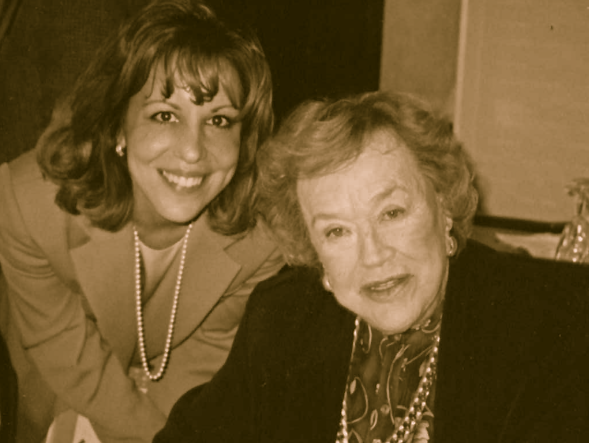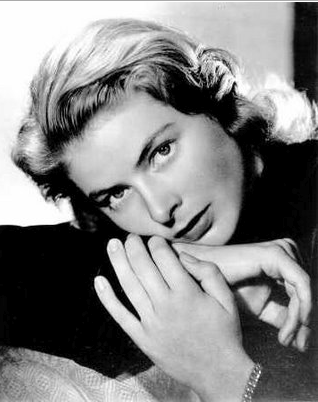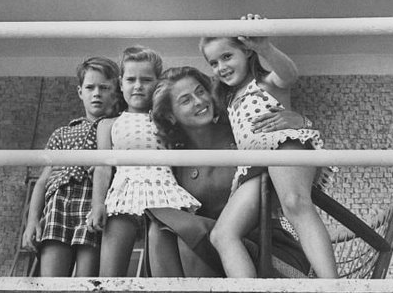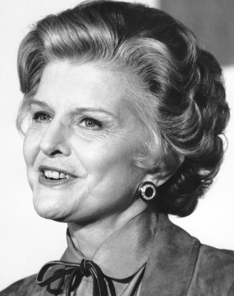Have you noticed? Only the most beautiful, accomplished, desirable and spectacular women get breast cancer? Every woman in this photo was a survivor. It includes Bette Davis, Ingrid Bergman, Myrna Loy, Hattie McDaniel, Vivian Vance, Jean Simmons, Rosalind Russell, Greta Garbo, Jennifer Jones and Paulette Goddard.

Julia Child

Gina Maisano and Julia Child, Old Westbury, New York 2000
“Everything in Moderation.... Including Moderation.” Julia Child
One of the greatest honors I ever have experienced in my life was meeting and having luncheon with my mentor and idol, Julia Child. Julia, who was first published at age 49. Julia, who first appeared on television at age 50. Julia, who stood firm defending the dignity of real butter and heavy cream in the face of the food police. Julia, who made a mess in a kitchen and laughed all the way. Julia, who dried lettuce by swinging it about splashing cameraman and anyone else in her way . Julia, who pounded veal into submission with wild abandon. Julia, who stood over six feet tall. Julia, a 36 year breast cancer survivor.
Julia. She was my baby sitter. My mother parked me in front of The French Chef when I was a child and thus began my lifelong love affair with cooking and food. She taught me the value of butter and to never underestimate the power of a good quality wine in any dish, “If you won’t drink it, don’t cook with it.”
Julia did not attend the CIA (Culinary Institute of America) but she worked for the CIA (Central Intelligence Agency) as a spy where she met her beloved husband Paul. It was Paul who put up that famous French Blue caulk board in her kitchen from where she could hang her pots and pans and keep them within easy reach. While living in France, she attended Le Cordon Bleu and studied with private chefs. In 1962, she wrote “Mastering the Art of French Cooking” known in my home as The Bible.
She believed in real food, real ingredients: Butter, Meat, Cream and Wine. I followed her guidance and when I was working as a chef, people always asked me how I made the food taste so good. “It is very simple." I would answer. "I use real food and butter and cream. The way Julia Child does.”
In 1968, at the age of 51, she was diagnosed with breast cancer. She had a mastectomy. And the French Chef you saw on TV all those years was an active, living, breathing, thriving, survivor. Her secret to long life? “Meat and Gin.”
Amen, Julia.
When I met her that spring day, I had a bustling catering business. In fact, that evening I had three parties booked. I brought with me my mother’s copy of Mastering The Art of French Cooking, that had become mine, for her to sign. I thought I would be composed. I have met many famous people in my life. But Julia was like a second mother to me. And here she was, sitting next to me for lunch. I started to cry. She put her arm around me and started to ask me questions about myself until I pulled myself together and we proceeded to have a lovely, unforgettable time.
Little did I know that only a couple of years later I would be diagnosed with breast cancer. I was feeling helpless. I was on line at the market and there was a magazine at the checkout that was listing “Celebrities with Breast Cancer.” I opened it, and there was Julia’s picture. A wave of relief and strength washed over me. Julia was a survivor. I didn't know that. I didn’t feel alone anymore. If she could survive this, so could I.
Julia Child was a magnificent, accomplished, kind hearted, innovative, funny, irreverent, loving woman, who also kicked the Beast to the curb like so much silver skin to be discarded from a filet in order to make the meat more beautiful and delicious. Just like she made her life.
I have followed her lead my whole life. I intend on doing so forever.
Ingrid Bergman

Several months went by, she not only continued with “The Constant Wife” but she also began filming Murder on the Orient Express. The play closed in 1974 and the lump was larger. She finally went to the London Clinic where she was told she had breast cancer. Back then, a woman went in for a biopsy and while still under anesthesia, the doctors tested the tumor. If it was found to be cancerous, an immediate radical mastectomy was performed. The patient does not know she has cancer until she wakes up and discovers her breast was removed. A radical mastectomy removed the breast, the lymph nodes, part of the chest wall and the pectoral muscle. It is a huge surgery and leaves the woman with a chest concavity and some level of disability in the arm of the affected side.
In her autobiography, she remembers how the doctor told her. She said, “The doctor came and I could read his face like an open book. I felt sorry for him because it must be an awful job to go around telling women they are mutilated.”
Like all breast cancer patients, she did her arm exercises. She recounts, “My arm felt useless and I could hardly lift it. But I did exercises and worked up the muscles in my hand and arm, and slowly I improved. I made pencil marks on my wardrobe door to see how high I could raise my arm.”
While filming Autumn Sonata in 1977 she found that her cancer had spread. She had another tumor removed from under her right arm followed by another radical mastectomy on the right breast after she found a large lump there. That surgery caused her to develop a severe form of lymphedema in her right arm.
As a last resort, she underwent chemotherapy. But this was only done after her cancer had spread. There were no drugs to control nausea then and it was very grueling. She never did chemotherapy in the early days of her diagnosis, only radiation, and unfortunately she was too late. It couldn’t help her at the point she was in her disease.
Ingrid Bergman died at the age of 67 on her birthday, on August 29, 1982
If Miss Bergman had been diagnosed today, she would have received a modified radical mastectomy that would not have left her debilitated. Chemotherapy would most likely have been started immediately. If her cancer was sensitive to hormones she would have been on aromatase inhibitors and would have lived a longer life with a better quality of life. Even her lymphedema would have been controlled better. Unfortunately, these things were not available to breast cancer patients in the 1970s, where even speaking of your cancer was not ever done in public.
Ingrid Bergman continued to act until her last days. She lived her life to the fullest and was ever-radiant, forever Ilsa. During her last acting role as Golda Meir, in her last days, she said,
“I would like to live my life as fully as I can until the last possible moment . At some point, you have to make peace with adverse circumstances … you have to bend. Bending is part of life.”

Betty Ford

Former First Lady, Betty Ford has died at the age of 93. She was an incredible woman who triumphed over cancer and addiction. We owe her a great deal of both thanks and respect.
In 1974, just a month after her husband suddenly became president, she discovered she had breast cancer. She underwent a mastectomy and did not hide it. As a result, she took the whisper out of the words, "breast cancer." She was our first, true advocate. Because of her example, other high profile women opened up about their own personal battles. Barbara Bel Geddes had a radical mastectomy around the same time as Mrs. Ford and made sure it was included in the storyline of her hit television show, Dallas. We all watched as Miss Ellie fought her cancer and her emotions about her body image and whether her husband would still desire her. This had never been seen or discussed before.
All of this led to empowering women to speak with their doctors about getting screened themselves, a topic that was not as open as it is today. The birth of the breast cancer advocacy movement can be traced to Mrs. Ford and Ms. Bel Geddes. Soon, radical mastectomies were stopped and less drastic and deforming surgeries were perfected leading to the beautiful reconstructive surgery available today.
Mrs. Ford did not keep anything secret for long. She was also an alcoholic. After she overcame her addiction, reached out to those who needed to break the bonds of substance abuse. The Betty Ford Clinic is famous for the work it does and the lives it has changed... all because Mrs. Ford wanted to help others yet again.
She may not have been flashy or known for her designer outfits. She was soft spoken and stood by her best friend, her husband, through good and bad times as he stood by her through her struggles. Quietly, without looking for credit, she went beyond herself to help others conquer what she had endured before them.
A quite warrior who won many wars, she was the friend you didn't realize you had. Who among us has not in some way been touched by breast cancer or substance abuse? Because of Mrs. Ford, there is no shame or embarrassment anymore. Courage, dignity and the knowledge that you can fight any battle is her legacy to us. We are incredibly lucky she was there for us. May she rest in peace.
Thank you, Mrs. Ford.
Alice Roosevelt Longworth

Theodore Roosevelt’s eldest child, Alice, was born to his first wife who died two days after Alice’s birth and a few hours before his own mother died. This precocious and beautiful child, who started her life so sadly, grew up to be a loving and joyful woman as well as the family rebel. Her spirit embodied the new century.
When her father became the President after William McKinley was assassinated, she became an instant celebrity known for her style and fashion sense. She also broke all the rules young women were meant to follow including smoking, partying, racing around Washington in her red car and even dabbled in gambling.
She frequently visited her father in the Oval Office, even while he conducted meetings, offering her own political view on the topic at hand. To say she exasperated the President would be an understatement. Her father notably remarked to a friend, after threatening to throw Alice out the window if she interrupted their meeting again, "I can either run the country or I can attend to Alice, but I cannot possibly do both."
Alice was, by far, the social center of attention during her father’s term in office, and she loved it. She loved politics. When her step-mother, the First Lady, was indisposed, she would appear in her place, entertaining all she met with her quick wit and rapid fire knowledge of world affairs.
She was the first First Daughter to serve as a goodwill ambassador, during a 1905 trip to Asia, which was the largest diplomatic mission in US history. She was the center of the news wherever she went. While she jumped, fully clothed, into the ship’s pool or attended Sumo wrestling matches, the press anxiously awaited her next move. This left her father free to complete the Treaty of Portsmouth which ended the Russo-Japanese War. As a result, Theodore Roosevelt was the first American to win the Nobel Peace Prize.
On this trip she met Ohio congressman Nicholas Longworth and married him soon after. Her wedding was the event of the year. He was fourteen years her senior and she was not exactly the picture of proper Washington wife. Instead, she became its most famous, best dressed, well-connected unelected politician. Alice was a force to be reckoned with in the District of Columbia.
They were a power couple to be sure, even though they were not always on the same team. Alice strongly and publicly supported her father and his Bull Moose Party as her ran for the Presidency in 1912. Her husband, however, backed his personal mentor, President Taft. She would even appear at Bull Moose Rallies in her husband’s own congressional district, which he lost by 105 votes. She claimed to be the reason her own husband lost the election. While that may have been true, he did win reelection in 1914 and remained in the House for the rest of his life and became Speaker.
Publicly campaigning against her own husband did not do much for their marriage. She eventually fell in love with Senator William Borah and gave birth to their daughter, Paulina in 1925. Her husband died in 1931 and when asked if she would like to be buried in Ohio as well, her emphatic response was that to be buried in Cincinnati “would be a fate worse than death itself.”
The Depression brought with it financial hardships for Alice and her young daughter. She appeared in advertisements and wrote her autobiography, Crowded Hours. The book was a hit and was critically acclaimed. She retained her social and political stature in the community and was widely known as “the other Washington Monument.”
From the 1950s through the 1970s she embraced the fight of African Americans for social and legal equality. She treated everyone equally no matter what their station of life. Once, in 1964, her African American chauffeur who was also one of her closest friends, was driving her when he pulled out in front of a taxi. The taxi driver got out of the cab and yelled at Alice’s friend, “ What do you think you’re doing, you black bastard?!” Alice’s friend took the insult quietly, not something Alice could tolerate. So she stepped up to the taxi driver and said, “He’s taking me to my destination you white son of a bitch!”
In 1956, Alice discovered she had breast cancer. She underwent a mastectomy and it was success. In 1970, the cancer returned to the remaining breast and she had a second mastectomy. Taking it in her usual Alice stride, she said she was the only "topless octogenarian" in Washington. Due to a lifetime of heavy smoking, in her later years she was diagnosed with emphysema.
After many years of ill health, Longworth died in her Embassy Row home in 1980 of emphysema and pneumonia. She was 96 years old and is buried in Washington, D.C.
Alice-isms...
I have a simple philosophy: Fill what's empty. Empty what's full. Scratch where it itches.
I've always believed in the adage that the secret of eternal youth is arrested development.
If you haven't got anything nice to say about anybody, come sit next to me.
My father always wanted to be the corpse at every funeral, the bride at every wedding and
the baby at every christening.
Jennifer Griffin

Jennifer discovered a large tumor in her breast. It was breast cancer. That is bad enough to hear for anyone. But then she heard that she had "the bad one," triple negative breast cancer. As a survivor of TNBC, I know what a shock that little tidbit added on to a terrifying diagnosis is like. But it appears that Jennifer is approaching this with the same grit and determination she uses in her professional life. She is fighting like hell.
I saw her on television last night and reached out to a friend to get in contact with her. Because if anyone embodies the No Surrender spirit it is Jennifer. She is working out during her chemo and eating right. She isn't schlepping around - she gets dressed and looks great, with an awesome collection of wigs. And I hope she is wearing those earrings of hers...
She is also fighting for women who have TNBC. We need voices like hers to help all of us. The more women we can educate about triple negative the better. That is what our Before Forty Initiative is all about.
I am glad to have Jennifer on our side. If anyone can get researchers to work harder and focus more on TNBC, it is her.
You can follow her journey on her blog: http://jengriffinblog.blogspot.com/
And Jennifer, from all of us here, we wish you the best and No Surrender!!!
Debbie Wasserman Schultz
After telling The Miami Herald that she had successfully fought breast cancer, Debbie Wasserman Schultz vowed to warn younger women about the risks.
BY LESLEY CLARK
WASHINGTON -- When Rep. Debbie Wasserman Schultz steps to the lectern at the Capitol on Monday to push for greater awareness of breast cancer risks in younger women, she'll be speaking from experience.
The Broward County Democrat and mother of three told The Miami Herald on Saturday that she successfully battled breast cancer for the past year and is going public with her story in the hope of alerting young women to its prevalence. She'll introduce legislation Monday that calls for a national education campaign targeting women between 15 and 39.
'I wanted to be able to not just stand up and say, `I'm a breast cancer survivor.' . . . I wanted to find a gap and try to fill it,'' said Wasserman Schultz, 42.
In the past year, she underwent seven major surgeries, including a double mastectomy and reconstructive surgery, while balancing motherhood, Congress and her roles as a chief fundraiser for House Democrats and a political surrogate, first for Hillary Clinton and then for Barack Obama.
''I had a lot going on last year,'' she said with a laugh, sitting in the living room of the Capitol Hill town house she shares with two other members of Congress when she's in Washington. ``I'm a very focused, methodical person, and I wasn't going to let this beat me. I wasn't going to let it interfere with my life.''
She'll share her experience on national television Monday morning on ABC's Good Morning America with anchor Robin Roberts, who had breast cancer in 2007.
''What I realized through the year is, I thought I knew a lot about breast cancer, but I really didn't, and most young women don't,'' Wasserman Schultz said.
DETECTION DIFFICULT
Breast cancer in younger women can be particularly aggressive, but it can be more difficult to detect because of breast density. And physicians, Wasserman Schultz said, can be slow to recognize the threat to younger women.
''Young women go skipping along through their life, thinking they're invincible, not worrying about breast cancer because they think of it as an older woman's disease,'' Wasserman Schultz said, noting that the focus is often on a woman's first mammogram, typically at 40.
The death rate from breast cancer has declined for older women, but remains stable for younger women because they are often diagnosed at a later stage, she said.
''It just pains me to know that younger women, because they don't know and because they're blown off by physicians many times, and because they squeeze their eyes shut and hope that it's nothing, that their death rate is much higher,'' she said.
Her bill calls for a national education campaign, aimed at informing young women about the risks and encouraging them to conduct routine self-exams.
Wasserman Schultz discovered a breast lump through a self-exam, two months after her first mammogram at 40. Although the cancer was detected at an early stage, she also learned that as an Ashkenazi Jew of Eastern European descent, she was at greater risk of carrying a gene mutation that makes Ashkenazi Jews predisposed to breast cancer and recurrance. She tested positive for this BRCA2 gene mutation, prompting her to have both breasts removed.
She was also at higher risk of ovarian cancer and had her ovaries removed -- the day after Election Day. Her final surgery was in December.
Because the cancer was caught so early, she didn't need chemotherapy or radiation but will take the cancer drug tamoxifen for five years.
She said she decided to keep her cancer private, concerned mostly that her young children (then 8-year-old twins and a 4-year-old daughter) would worry, particularly with a mother who was also constantly on the go. They knew she was undergoing surgery, but she didn't tell them the cause.
'I knew from my doctors that if I went through their recommended course of treatment that I would get through it and I'd be fine, that I could come out the other side and confidently tell my children, `Mommy's fine,' '' she said.
She scheduled her treatment at Walter Reed Army Medical Center and the National Naval Medical Center in Bethesda, Md., during congressional recesses so she wouldn't miss votes in Congress.
THIRD TERM IN HOUSE
Wasserman Schultz is one of the most influential Democratic House members from Florida. She was easily reelected to her third term in November and is vice chair of the Democratic National Committee.
She said that keeping her illness to a small circle of family members and friends allowed her to ''maintain control'' over a situation that was otherwise out of control.
''I didn't want it to define me,'' she said. 'I didn't want when you wrote a story about me, I would become `Debbie Wasserman Schultz, who is battling breast cancer.' I didn't want that to be my name because I knew I was going to be fine.''
The No Surrender Breast Cancer Foundation is a 501 c 3 Not-For-Profit Organization. Please see our Disclaimer and Terms of Use.